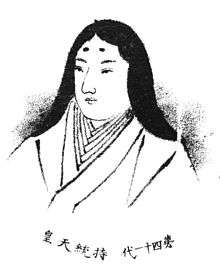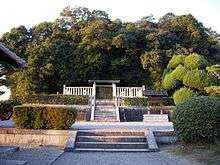Empress Jitō
| Jitō | |
|---|---|
 | |
| Empress of Japan | |
| Reign | 686–697 |
| Predecessor | Tenmu |
| Successor | Monmu |
| Born |
Princess Uno-no-sarara 645 |
| Died |
703 (aged 57–58) Fujiwara-kyō, Japan |
| Burial | Hinokuma-no-Ōuchi no misasagi (Nara) |
| Spouse | Emperor Tenmu |
| Issue | Prince Kusakabe |
| House | Yamato |
| Father | Emperor Tenji |
| Mother | Soga no Ochi-no-iratsume |
Empress Jitō (持統天皇 Jitō-tennō, 645 – 13 January 703) was the 41st monarch of Japan,[1] according to the traditional order of succession.[2]
Jitō's reign spanned the years from 686 through 697.[3]
In the history of Japan, Jitō was the third of eight women to take on the role of empress regnant. The two female monarchs before Jitō were Suiko and Kōgyoku/Saimei. The five women sovereigns reigning after Jitō were Genmei, Genshō, Kōken/Shōtoku, Meishō, and Go-Sakuramachi.
Traditional narrative
Empress Jitō was the daughter of Emperor Tenji. Her mother was Ochi-no-Iratsume, the daughter of Minister Ō-omi Soga no Yamada-no Ishikawa Maro. She was the wife of Tenji's full brother Emperor Tenmu, whom she succeeded on the throne.[4]
Empress Jitō's given name was Unonosarara or Unonosasara (鸕野讚良), or alternately Uno.[5]
Events of Jitō's reign
Jitō took responsibility for court administration after the death of her husband, Emperor Tenmu, who was also her uncle. She acceded to the throne in 687 in order to ensure the eventual succession of her son, Kusakabe-shinnō. Throughout this period, Empress Jitō ruled from the Fujiwara Palace in Yamato.[4] In 689, Jitō prohibited Sugoroku,[6] in 690 at enthronement she performed special ritual then gave pardon and in 692 she travelled to Ise against the counsel of minister Miwa-no-Asono-Takechimaro.[7]
Prince Kusakabe was named as crown prince to succeed Jitō, but he died at a young age. Kusakabe's son, Karu-no-o, was then named as Jitō's successor. He eventually would become known as Emperor Monmu.[4]
Empress Jitō reigned for eleven years. Although there were seven other reigning empresses, their successors were most often selected from amongst the males of the paternal Imperial bloodline, which is why some conservative scholars argue that the women's reigns were temporary and that male-only succession tradition must be maintained in the 21st century.[8] Empress Genmei, who was followed on the throne by her daughter, Empress Genshō, remains the sole exception to this conventional argument.
In 697, Jitō abdicated in Mommu's favor; and as a retired sovereign, she took the post-reign title daijō-tennō. After this, her imperial successors who retired took the same title after abdication.[4]
Jitō continued to hold power as a cloistered ruler, which became a persistent trend in Japanese politics.
The actual site of Jitō's grave is known.[1] This empress is traditionally venerated at a memorial Shinto shrine (misasagi) at Nara.
The Imperial Household Agency designates this location as Jitō's mausoleum. It is formally named Ochi-no-Okanoe no misasagi.[9]
Kugyō
Kugyō (公卿) is a collective term for the very few most powerful men attached to the court of the Emperor of Japan in pre-Meiji eras.
In general, this elite group included only three to four men at a time. These were hereditary courtiers whose experience and background would have brought them to the pinnacle of a life's career. During Jitō's reign, this apex of the Daijō-kan included:
- Daijō-daijin, Takechi-shinnō (the 3rd son of Emperor Tenmu)[5]
- Sadaijin
- Udaijin
- Naidaijin
Non-nengō period
Jitō's reign is not linked by scholars to any era or nengō.[3] The Taika era innovation of naming time periods – nengō – languished until Mommu reasserted an imperial right by proclaiming the commencement of Taihō in 701.
- See Japanese era name – "Non-nengo periods"
- See Jitō period (687–697).
However, Brown and Ishida's translation of Gukanshō offers an explanation which muddies a sense of easy clarity:
- "The eras that fell in this reign were: (1) the remaining seven years of Shuchō [(686+7=692?)]; and (2) Taika, which was four years long [695–698]. (The first year of this era was kinoto-hitsuji [695].) ... In the third year of the Taka era [697], Empress Jitō yielded the throne to the Crown Prince."[5]
Poetry
Man'yōshū poetry
The Man'yōshū includes a poem said to have been composed by Jitō
- After the death of the Emperor Tenmu[10]
- Oh, the autumn foliage
- Of the hill of Kamioka![11]
- My good Lord and Sovereign
- Would see it in the evening
- And ask of it in the morning.
- On that very hill from afar
- I gaze, wondering
- If he sees it to-day,
- Or asks of it to-morrow.
- Sadness I feel at eve,
- And heart-rending grief at morn –
- The sleeves of my coarse-cloth robe
- Are never for a moment dry.
Hyakunin Isshu poetry
One of the poems attributed to Empress Jitō was selected by Fujiwara no Teika for inclusion in the very popular anthology Hyakunin Isshu.
- Poem number 2[14]
|
|
Ancestry
| Ancestors of Empress Jitō | |||||||||||||||||||||||||||||||||||||||||||||||||||||||||||||||||||||||||||||||||||||||||||||||||||||||||||||||||||||||||||||||||||||||||||||||||||||||||||||||||||||||||||||||||||||||||||||||||||||||||||||||||||||||||||||||||||||||||||||||||||||||||||||||||||||||||||||||||||||||||||||||||||||||||||||||||||||||||||||||||||||||||||||||||||||||||||||||||||||||||||||||||||||||||||||||||||||||||||||||||||||||||||||||||||||||||||||||||||||||||||||||||||||||||||||||||||
|---|---|---|---|---|---|---|---|---|---|---|---|---|---|---|---|---|---|---|---|---|---|---|---|---|---|---|---|---|---|---|---|---|---|---|---|---|---|---|---|---|---|---|---|---|---|---|---|---|---|---|---|---|---|---|---|---|---|---|---|---|---|---|---|---|---|---|---|---|---|---|---|---|---|---|---|---|---|---|---|---|---|---|---|---|---|---|---|---|---|---|---|---|---|---|---|---|---|---|---|---|---|---|---|---|---|---|---|---|---|---|---|---|---|---|---|---|---|---|---|---|---|---|---|---|---|---|---|---|---|---|---|---|---|---|---|---|---|---|---|---|---|---|---|---|---|---|---|---|---|---|---|---|---|---|---|---|---|---|---|---|---|---|---|---|---|---|---|---|---|---|---|---|---|---|---|---|---|---|---|---|---|---|---|---|---|---|---|---|---|---|---|---|---|---|---|---|---|---|---|---|---|---|---|---|---|---|---|---|---|---|---|---|---|---|---|---|---|---|---|---|---|---|---|---|---|---|---|---|---|---|---|---|---|---|---|---|---|---|---|---|---|---|---|---|---|---|---|---|---|---|---|---|---|---|---|---|---|---|---|---|---|---|---|---|---|---|---|---|---|---|---|---|---|---|---|---|---|---|---|---|---|---|---|---|---|---|---|---|---|---|---|---|---|---|---|---|---|---|---|---|---|---|---|---|---|---|---|---|---|---|---|---|---|---|---|---|---|---|---|---|---|---|---|---|---|---|---|---|---|---|---|---|---|---|---|---|---|---|---|---|---|---|---|---|---|---|---|---|---|---|---|---|---|---|---|---|---|---|---|---|---|---|---|---|---|---|---|---|---|---|---|---|---|---|---|---|---|---|---|---|---|---|---|---|---|---|---|---|---|---|---|---|---|---|---|---|---|---|---|---|---|---|---|---|---|---|---|---|---|---|---|---|---|---|---|---|---|---|---|---|---|---|---|---|---|---|---|---|---|---|---|---|---|---|---|---|---|---|---|---|---|---|---|---|---|---|---|---|---|---|---|---|---|---|---|---|---|---|---|---|---|---|---|---|---|---|---|
| |||||||||||||||||||||||||||||||||||||||||||||||||||||||||||||||||||||||||||||||||||||||||||||||||||||||||||||||||||||||||||||||||||||||||||||||||||||||||||||||||||||||||||||||||||||||||||||||||||||||||||||||||||||||||||||||||||||||||||||||||||||||||||||||||||||||||||||||||||||||||||||||||||||||||||||||||||||||||||||||||||||||||||||||||||||||||||||||||||||||||||||||||||||||||||||||||||||||||||||||||||||||||||||||||||||||||||||||||||||||||||||||||||||||||||||||||||
See also
Notes

- 1 2 Imperial Household Agency (Kunaichō): 持統天皇 (41)
- ↑ Ponsonby-Fane, Richard. (1959). The Imperial House of Japan, p. 54.
- 1 2 Titsingh, Isaac. (1834). Annales des empereurs du Japon, p. 59., p. 59, at Google Books
- 1 2 3 4 Varley, H. Paul. Jinnō Shōtōki, p. 137.
- 1 2 3 Brown, D. (1979). Gukanshō, p. 270.
- ↑ Nihon Shoki, Volume 30
- ↑ Nihon Shoki, Volume, 30
- ↑ "Life in the Cloudy Imperial Fishbowl", Japan Times. March 27, 2007.
- ↑ Ponsonby-Fane, p. 420.
- ↑ Nippon Gakujutsu Shinkōkai, p.18. This waka is here numbered 42; in the Kokka Taikan (1901), Book II, numbered 159.
- ↑ Nippon Gakujutsu Shinkōkai, p. 18 n1; n.b., This would be the so-called Thunder Hill in the village of Asuka near Nara.
- ↑ Nippon Gakujutsu Shinkōkai, p. 47; n.b., This waka is here numbered 118; in the Kokka Taikan (1901), Book III, numbered 235.
- ↑ Nippon Gakujutsu Shinkōkai, p. 47 n4; n.b., This poem is based on the idea that the Sovereigns are the offspring of Amaterasu-omikami, and that their proper sphere is heaven. There the Thunder Hill is regarded as the actual embodiment of Thunder.
- ↑ "University of Virginia, ''Hyakunin Isshu'' on-line". Etext.lib.virginia.edu. Retrieved 2012-06-10.
- ↑ "Genealogy". Reichsarchiv. Retrieved 26 January 2018. (in Japanese)
References
- Aston, William George. (1896). Nihongi: Chronicles of Japan from the Earliest Times to A.D. 697. London: Kegan Paul, Trench, Trubner. OCLC 448337491
- Brown, Delmer M. and Ichirō Ishida, eds. (1979). Gukanshō: The Future and the Past. Berkeley: University of California Press. ISBN 978-0-520-03460-0; OCLC 251325323
- MacCauley, Clay. (1900). "Hyakunin-Isshu: Single Songs of a Hundred Poets" in Transactions of the Asia Society of Japan. Tokyo: Asia Society of Japan. ...Click link for digitized, full-text copy (in English)
- __________. (1901). Kokka taikan. Tokyo: Teikoku Toshokan, Meiji 30–34 [1897–1901]. [reprinted Shinten kokka taikan (新編国歌大観), 10 vols. + 10 index vols., Kadokawa Shoten, Tokyo, 1983–1992. ISBN 978-4-04-020142-9
- Nippon Gakujutsu Shinkōkai. (1940). Man'yōshū. Tokyo: Iwanami shoten. [reprinted by Columbia University Press, New York, 1965. ISBN 0-231-08620-2. Rprinted by Dover Publications, New York, 2005. ISBN 978-0-486-43959-4
- Ponsonby-Fane, Richard Arthur Brabazon. (1959). The Imperial House of Japan. Kyoto: Ponsonby Memorial Society. OCLC 194887
- Titsingh, Isaac. (1834). Nihon Ōdai Ichiran; ou, Annales des empereurs du Japon. Paris: Royal Asiatic Society, Oriental Translation Fund of Great Britain and Ireland. OCLC 5850691
- Varley, H. Paul. (1980). Jinnō Shōtōki: A Chronicle of Gods and Sovereigns. New York: Columbia University Press. ISBN 978-0-231-04940-5; OCLC 59145842
External links
- Asuka Historical National Government Park: image of Mausoleum Emperor Tenmu and Empress Jitō, exterior view
| Regnal titles | ||
|---|---|---|
| Preceded by Emperor Tenmu |
Empress of Japan: Jitō 686–697 |
Succeeded by Emperor Monmu |
